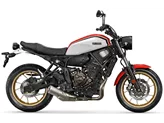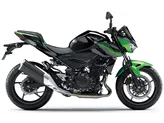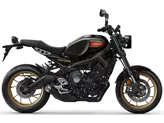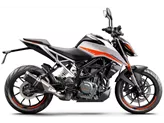Yamaha XSR700 2015 vs. Kawasaki Z650 2017

Yamaha XSR700 2015

Kawasaki Z650 2017
Overview - Yamaha XSR700 2015 vs Kawasaki Z650 2017
The Yamaha XSR700 2015 and the Kawasaki Z650 2017 are both naked bikes with similar engine types, fuel systems, and cooling systems. However, there are some notable differences between the two models.
In terms of engine power, the Yamaha XSR700 has a slight advantage with 75 HP compared to the Kawasaki Z650's 68.2 HP. The Yamaha also has a higher torque of 68 Nm compared to the Kawasaki's 65.7 Nm. Both bikes have two cylinders and a displacement of around 650cc.
In terms of suspension, both bikes have a telescopic fork front suspension and a swing arm rear suspension with a monoshock absorber. The Yamaha XSR700 has a steel frame, while the Kawasaki Z650 also has a steel frame.
When it comes to braking, both bikes have double disk front brakes. However, the Yamaha XSR700 has a slightly smaller diameter of 282 mm compared to the Kawasaki Z650's 300 mm. The Yamaha also has four-piston front brakes, while the Kawasaki has double-piston front brakes.

Yamaha XSR700 2015
Both bikes come with ABS as an advanced rider assistance system, which provides added safety during braking.
In terms of dimensions and weights, the Yamaha XSR700 has a slightly wider rear tire at 180 mm compared to the Kawasaki Z650's 160 mm. The Yamaha also has a slightly longer wheelbase of 1405 mm compared to the Kawasaki's 1410 mm. The seat height of the Yamaha is 815 mm, while the Kawasaki has a lower seat height of 790 mm. The Yamaha XSR700 also has a slightly higher kerb weight of 186 kg compared to the Kawasaki Z650's 187.1 kg. Both bikes have a similar fuel tank capacity, with the Yamaha having 14 liters and the Kawasaki having 15 liters.
Now let's discuss the strengths and weaknesses of each bike. The Yamaha XSR700 has a very agile engine, providing a responsive and enjoyable riding experience. It also has a comfortable yet sporty chassis and a comfortably upright seating position, making it suitable for long rides. The retro look of the Yamaha XSR700 is also a standout feature, appealing to riders who appreciate classic designs. Additionally, the bike comes with complete instrumentation and good brakes. Another advantage of the Yamaha XSR700 is the availability of many accessories, allowing riders to personalize their bike.

Kawasaki Z650 2017
On the other hand, the Kawasaki Z650 has an even power delivery, providing smooth acceleration. It also has a sporty chassis and compact dimensions, making it nimble and easy to maneuver. The negative display on the Kawasaki Z650's instrumentation adds a modern touch to the bike's design.
However, the Yamaha XSR700 does have some weaknesses. The suspension may be too soft for extremely sporty riding, which could affect the bike's handling in aggressive maneuvers. Additionally, the digital rev counter on the Yamaha XSR700 may be difficult to read in certain lighting conditions. Another drawback of the Yamaha XSR700 is its higher price compared to the basic MT-07 model.
As for the Kawasaki Z650, one weakness is that it may feel a little too small for taller riders, potentially compromising comfort on long rides.
In summary, both the Yamaha XSR700 2015 and the Kawasaki Z650 2017 have their own strengths and weaknesses. The Yamaha offers a more powerful engine and a retro look, while the Kawasaki provides a smooth power delivery and compact dimensions. Ultimately, the choice between the two will depend on the rider's preferences and priorities.
Technical Specifications Yamaha XSR700 2015 compared to Kawasaki Z650 2017
Pros and Cons in comparison
Pros and Cons in comparison
Yamaha XSR700 2015

With the XSR700, Yamaha has once again hit the jackpot. The retro look with modern elements is currently very popular with customers. The fact that it is based on the affordable MT-07 is not at all a problem, as the entry-level bike is known for being extremely sporty and agile. The XSR700's comfortable chassis and upright riding position are a perfect match. The price of almost 9,000 euros seems steep at first glance, especially in comparison to the MT-07, but the improved appearance and exclusivity make up for the money.
Kawasaki Z650 2017

The Kawasaki Z 650 is the tip of the middle class for small male and female riders. On its compact dimensions, you probably won't feel comfortable as a giant. Heart-warming feelings, however, come from the engine, which delights with a very smooth pull. On the chassis side, a Kawasaki-typical tight set-up was chosen, which finds a great compromise in everyday use. The negative display is very easy to read and is reminiscent of its predecessor, the ER-6n - very nice!
Price Comparison Avarage Market Price Yamaha XSR700 vs Kawasaki Z650
There are a few key differences between a Yamaha XSR700 2015 and a Kawasaki Z650 2017. It takes less time to sell a Kawasaki Z650 with 76 days compared to 155 days for the Yamaha XSR700. Since model year 2015 1000PS.de editors have written 26 reviews for the Yamaha XSR700 and 31 reviews for the Kawasaki Z650 since model year 2017. The first review for the Yamaha XSR700 was published on 7/22/2015 and now has more than 13,700 views. This compares to more than 25,000 views for the first review on Kawasaki Z650 published on 11/8/2016.



















